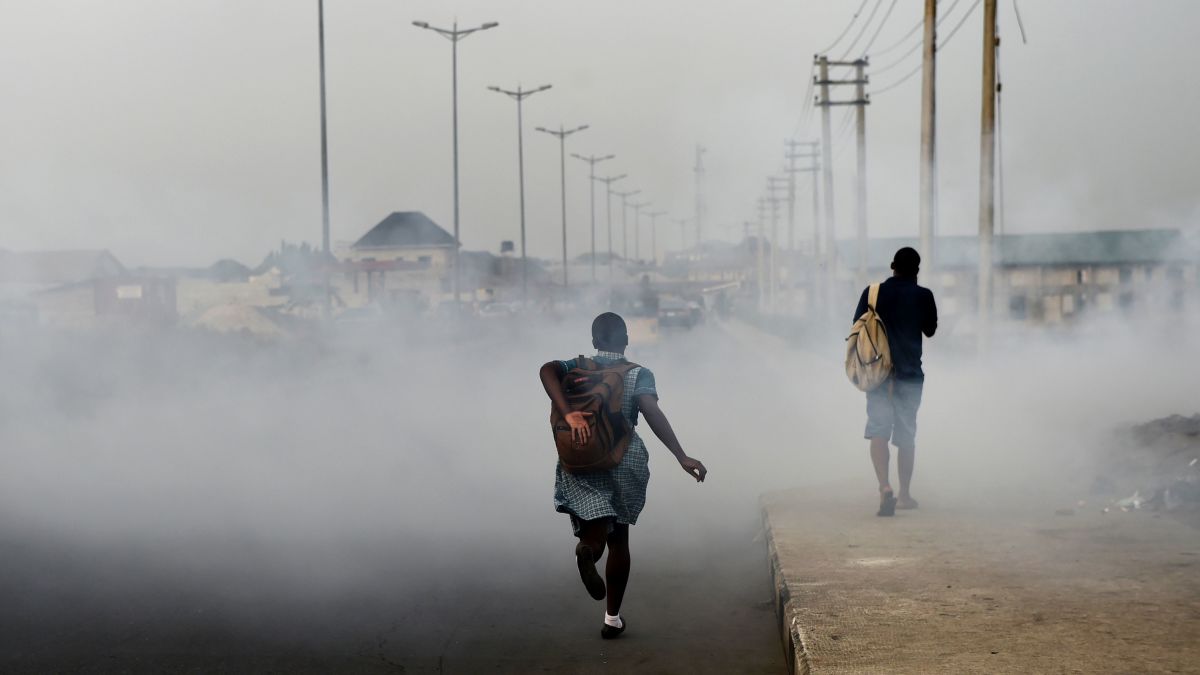Cleaner air has increased the number of city heatwaves – New Scientist

Report on the Climatic Impact of Aerosol Pollution Reduction and its Link to Sustainable Development Goals
1.0 Executive Summary
Recent climate analysis reveals that successful efforts to reduce harmful aerosol pollution are inadvertently accelerating the frequency of heatwaves, particularly in populated regions. This phenomenon occurs because aerosols, primarily from fossil fuel combustion, have historically masked a significant portion of the warming caused by greenhouse gases. As air quality improves, this cooling effect diminishes, unmasking the full impact of atmospheric carbon. This report examines the findings of a recent climate modeling study, focusing on the profound implications for several United Nations Sustainable Development Goals (SDGs), including those related to health, urban sustainability, and climate action.
2.0 Analysis of Aerosol and Greenhouse Gas Interactions
2.1 The Dual Role of Aerosol Pollution
Aerosol pollution and greenhouse gases, both by-products of fossil fuel consumption, have opposing effects on the global climate. This dynamic is central to understanding current warming trends.
- Greenhouse Gases: Substances like carbon dioxide trap heat within the atmosphere, leading to a gradual increase in global temperatures.
- Aerosol Pollution: Particulates in the atmosphere reflect solar radiation back into space, either directly or by altering cloud properties. This creates a cooling effect that has offset as much as half of the warming attributed to greenhouse gases to date.
Consequently, policies aimed at improving air quality by reducing aerosols have the unintended consequence of increasing the net warming effect on the climate.
2.2 Key Findings from Climate Modeling
A climate model was utilized to simulate the specific impact of changing aerosol levels on the frequency of heatwaves. A heatwave was defined as three consecutive days within the top 10% of hottest days for that period in a pre-industrial climate. The primary findings are as follows:
- Historical Trend Reversal: For most of the 20th century, increasing aerosol pollution slowed the rate at which heatwaves became more frequent. After 2005, as global air quality measures took effect, this trend reversed, and declining aerosol levels began to accelerate the increase in heatwaves.
- Accelerated Heatwave Frequency: The reduction in aerosols is now contributing to an increase in heatwaves by approximately two days per decade globally.
- Disproportionate Impact on Populated Areas: The influence of aerosol reduction on heatwave frequency is more than twice as significant as the influence of rising greenhouse gas concentrations in densely populated areas, where aerosol concentrations have historically been highest.
3.0 Implications for Sustainable Development Goals (SDGs)
3.1 SDG 3: Good Health and Well-being
The reduction of air pollution is a critical public health imperative, directly aligning with SDG Target 3.9, which aims to reduce deaths and illnesses from air pollution. However, the resulting increase in extreme heat events presents a new and significant health risk, potentially leading to a rise in heat-related morbidity and mortality. This creates a complex public health trade-off that requires integrated policy solutions.
3.2 SDG 11: Sustainable Cities and Communities
The findings carry major implications for urban environments. The amplified warming in populated areas directly challenges the resilience of cities and human settlements.
- SDG Target 11.5: Efforts to reduce the number of deaths and economic losses caused by climate-related disasters must now account for the increased risk of severe heatwaves resulting from improved air quality.
- SDG Target 11.6: While cities work to reduce their environmental impact and improve air quality, they must simultaneously implement adaptive strategies to manage extreme heat, requiring fundamental changes to urban infrastructure and public services.
3.3 SDG 13: Climate Action
This research underscores the complexity of climate science and the need for holistic policy-making. It highlights a critical feedback loop that must be integrated into climate strategies.
- SDG Target 13.1: Nations must strengthen resilience and adaptive capacity to climate-related hazards, recognizing that successful environmental policies in one domain (air pollution) can exacerbate risks in another (extreme heat).
- SDG Target 13.2: Climate change measures must be integrated into national policies that consider the interconnected effects of reducing both aerosols and greenhouse gases simultaneously, reinforcing the urgency of transitioning away from fossil fuels, the common source of both pollutants.
4.0 Future Projections and Report Limitations
4.1 Long-Term Scenario
Under a high-emissions scenario where greenhouse gases continue to rise and aerosol pollution moderately declines, the model projects a dramatic escalation in heatwave frequency. The average number of heatwave days in populated areas is projected to increase from approximately 40 per year at present to over 110 per year by 2080. Such a change would necessitate a fundamental transformation in societal operations.
4.2 Uncertainties and Outlook
The conclusions are compelling but subject to certain limitations and uncertainties that warrant further investigation:
- The analysis is based on a single climate model. Results should be cross-validated with other models.
- The projections utilize a worst-case scenario for greenhouse gas emissions.
- There is a need to detect and confirm these effects in historical observational data.
- Future pathways for aerosol concentrations over the next three decades remain highly uncertain.
SDGs Addressed in the Article
The article discusses issues that are directly and indirectly connected to several Sustainable Development Goals. The primary focus on air pollution, its health impacts, and its paradoxical effect on climate change (specifically heatwaves) touches upon goals related to health, urban living, and climate action.
-
SDG 3: Good Health and Well-being
The article explicitly states that “Reducing aerosol pollution is a public health imperative,” directly linking the issue of air quality to human health. Aerosol pollution, which comes from burning fossil fuels, is known to cause respiratory and other health problems. The article’s core tension is that the necessary action to improve public health by cleaning the air has the unintended consequence of increasing heatwaves, another significant health risk.
-
SDG 11: Sustainable Cities and Communities
The article highlights that the warming influence of reduced aerosols is “even greater in populated places.” It notes that aerosol concentrations are highest “where people are,” making cities and populated areas particularly vulnerable to the accelerated increase in heatwaves. The projection that heatwave days in populated areas could rise from 40 to over 110 per year implies that these events will “require fundamental changes in how many of these places operate,” which is a core concern of sustainable urban development.
-
SDG 13: Climate Action
This is the central SDG addressed. The article is entirely focused on a complex aspect of climate change. It explains how aerosols have “masked as much as half of the warming effect of greenhouse gases” and how their reduction is now unmasking this warming, leading to an “accelerate[d] increase in heatwaves across the planet.” The research presented models future climate scenarios and discusses the increasing frequency of climate-related hazards (heatwaves), which is a key component of SDG 13.
Specific SDG Targets Identified
Based on the content of the article, several specific SDG targets can be identified as being directly relevant to the problems discussed.
-
Target 3.9: By 2030, substantially reduce the number of deaths and illnesses from hazardous chemicals and air, water and soil pollution and contamination.
The article’s statement that reducing aerosol pollution is a “public health imperative” directly aligns with this target. Aerosols are a form of air pollution, and the effort to clean them up is aimed at reducing the illnesses and deaths they cause, even if it has other climatic consequences.
-
Target 11.6: By 2030, reduce the adverse per capita environmental impact of cities, including by paying special attention to air quality…
The article’s focus on the impact of aerosols in “populated places” and the statement that concentrations are highest “where people are” directly relates to urban air quality. The entire discussion is framed around the consequences of managing (i.e., reducing) a key component of urban air pollution.
-
Target 13.1: Strengthen resilience and adaptive capacity to climate-related hazards and natural disasters in all countries.
The article’s main finding is the accelerated increase in heatwave frequency, a significant climate-related hazard. The projection of a dramatic increase in heatwave days to “over 110 days per year by 2080” underscores the urgent need for societies, especially in populated areas, to build resilience and adapt to these more frequent extreme weather events.
Indicators for Measuring Progress
The article mentions or implies several metrics that can be used as indicators to measure the status and progress of the identified targets.
-
Indicator for Target 11.6 (and indirectly for 3.9): Annual mean levels of fine particulate matter (e.g. PM2.5 and PM10) in cities.
The article consistently refers to “aerosol pollution” and its “concentrations in the atmosphere.” Aerosols are a form of particulate matter. Monitoring the concentration of these aerosols, especially in “populated places,” is the direct way to measure the success of air pollution reduction efforts. The article discusses how “declines in aerosols began to accelerate the increase in heatwaves,” implying that these aerosol levels are being measured and tracked over time.
-
Indicator for Target 13.1: Frequency and duration of extreme weather events.
The article provides a very specific, measurable indicator for climate-related hazards. The researchers defined a heatwave as “three consecutive days that would have been among the hottest 10 per cent of days… in a pre-industrial climate.” They then measure the change in the frequency of these events, finding an acceleration of “about two days per decade” and projecting an increase in the “average number of days with heatwaves in populated areas” from “about 40 per year to over 110 days per year by 2080.” This provides a clear metric for tracking the increasing risk from this specific natural disaster.
Summary of SDGs, Targets, and Indicators
| SDGs | Targets | Indicators |
|---|---|---|
| SDG 3: Good Health and Well-being | 3.9: Substantially reduce deaths and illnesses from air pollution. | The article implies the need to monitor health outcomes related to air quality by stating that reducing aerosol pollution is a “public health imperative.” The concentration of aerosols is a proxy indicator for the pollution causing these health issues. |
| SDG 11: Sustainable Cities and Communities | 11.6: Reduce the adverse per capita environmental impact of cities, paying special attention to air quality. | Concentration of aerosols in populated places: The article focuses on aerosol concentrations “where people are,” which directly corresponds to indicator 11.6.2 (Annual mean levels of fine particulate matter in cities). |
| SDG 13: Climate Action | 13.1: Strengthen resilience and adaptive capacity to climate-related hazards and natural disasters. | Frequency and duration of heatwaves: The article quantifies this by defining a heatwave and measuring the increase in heatwave days per decade and projecting the number of heatwave days per year (from 40 to over 110 by 2080). |
Source: newscientist.com

What is Your Reaction?
 Like
0
Like
0
 Dislike
0
Dislike
0
 Love
0
Love
0
 Funny
0
Funny
0
 Angry
0
Angry
0
 Sad
0
Sad
0
 Wow
0
Wow
0
















































































